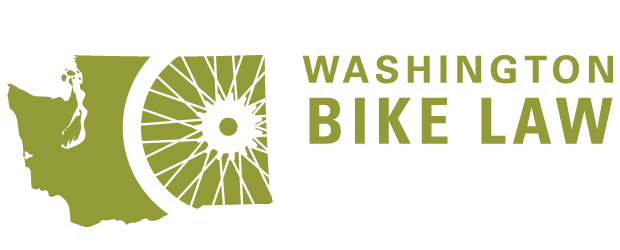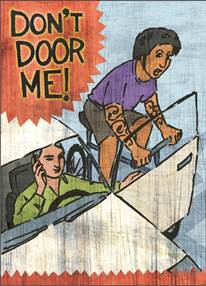Everyone knows the law when it comes to bicycles, right? Maybe not.
Consider these ten issues:
1. Bicycles on the Sidewalk
Whether one can ride a bike on the sidewalk depends upon where that sidewalk is, but contrary to popular belief, it’s generally allowed.
Seattle bicyclists may ride on any sidewalk provided they do so in a “careful and prudent manner.” [SMC 11.44.120]
Bellevue bicyclists can ride on the sidewalk unless this would “unreasonably inconvenience pedestrians.” [BMC 11.60.070]
Anywhere in Washington, unless otherwise locally legislated, “every person riding a bicycle upon a sidewalk or crosswalk must be granted all of the rights and is subject to all of the duties applicable to a pedestrian by this chapter.” [RCW 46.61.755(2)]
For other locations, see the “City and County Codes” link at www.washingtonbikelaw.com.
2. Bike Lights
State law requires bike lighting during the “hours of darkness.” [RCW 46.61.780] The “hours of darkness” generally begin 30 minutes after sunset and end 30 minutes before sunrise. [RCW 46.37.020]
3. Opening Doors
Bike messengers and other urban bicyclists use the phrase “getting doored” to mean being hit by an abruptly opened vehicle door.
State law says clearly that drivers and their passengers shall not:
open the door of a motor vehicle on the side adjacent to moving traffic unless and until it is reasonably safe to do so, and can be done without interfering with the movement of other traffic, nor shall any person leave a door open on the side of a vehicle adjacent to moving traffic for a period of time longer than necessary to load or unload passengers.
[RCW 46.61.620]
4. Passing on the Right
The Seattle Code specifically allows bicyclists to pass cars on the right when safe. [SMC 11.44.080]
The state rules of the road are more complicated, but also allow passing on the right in some situations.
5. NEW Statewide Passing Laws
No Passing When Approaching: Drivers may no longer cross the center line to pass when they can see a bicyclist or pedestrian “approaching from the opposite direction” or who is simply “present” when this would be “within a distance unsafe to the bicyclist or pedestrian due to the width or condition of the roadway, shoulder, or bicycle lane.” [RCW 46.61.125(1)(d)]
Stay Left Until Clear: When approaching a bicycle or pedestrian in the road, on the right shoulder, or in a bike lane, passing drivers have a duty to stay left “at a safe distance to clearly avoid coming in contact with the pedestrian or bicyclist, and shall not again drive to the right side of the roadway until safely clear of the overtaken pedestrian or bicyclist.” [RCW 46.61.110(2)]
6. Crosswalks
Seattle’s SMC 11.44.100 gives bikers using crosswalks “all the rights and duties applicable to a pedestrian under the same circumstances”, meaning that motor vehicles must yield to bikes.
Bicyclists shouldn’t be too bold with this law, however. SMC 11.44.100 also requires bikers to yield to pedestrians in the crosswalk and says “No person operating a bicycle shall suddenly enter a crosswalk into the path of a vehicle which is so close that the driver cannot yield safely.”
7. Bicyclists Side-by-Side
SMC 11.44.060 forbids bicyclists to ride “more than two (2) abreast”, thus, two bikes side-by-side would appear to be allowed. The exception is “on paths or parts of roadways set aside for the exclusive use of bicycles.” On these bikeways, there appears to be no specific limitation on the number of bicyclists who can ride side-by-side.
8. Helmets
While some counties and cities require helmets for bicyclists, there is no state-wide requirement. Perhaps there should be.
Studies by Group Health and the Harborview Injury Prevention and Research Center show that helmet use could prevent up to 85% of bicyclists’ head injuries.
According to the King County Board of Health, if every cyclist wore a helmet, the county could save nearly $10 million a year in direct and indirect costs for head injuries.
Bicyclists are required to wear helmets in King County, but the actual law is harder to find than some questionable tax loopholes.
Where is the local helmet law? In the Seattle Municipal Code? No. In the King County Code? Nope. With some determination, you might find it hidden in the King County Board of Health Code, provided you can find the King County Board of Health Code.
The hard-to-find law states, “Any person operating or riding on a bicycle not powered by motor on a public roadway, bicycle path or on any right-of-way or publicly owned facilities located in King County including Seattle, shall wear a protective helmet designed for bicycle safety.” [BOH 9.10.010(A)]
Any police officer can impose a $30 fine for violations of this law, however few do, perhaps because they can’t find the helmet law under which to make the charge.
9. Drunk Riding is Not Subject to DUI Laws
While it may not be legal to ride without a helmet, it appears to be legal to ride while intoxicated. There is a specific RCW provision on “Intoxicated bicyclists”. It allows a police officer to “offer to transport a bicycle rider who appears to be under the influence of alcohol or any drug” to a “safe place”. [RCW 46.61.790] However, it also states that the officer “shall not provide the assistance offered if the bicycle rider refuses to accept it.”
Apparently, the worst that can happen (at least as far as criminal issues are concerned) is the impoundment of a bike “if the officer determines that impoundment is necessary to reduce a threat to public safety, and there are no reasonable alternatives to impoundment.” And, “The bicycle must be returned without payment of a fee.”
The Washington Court of Appeals specifically held in City of Montesano v. Daniel Wells that “neither legislative intent, the statutory scheme, nor public policy support the conclusion that [the DUI law] was intended to apply to bicyclists.”
The court noted that “drunk bicyclists are not capable of causing the tremendous ‘carnage and slaughter’ associated with drunk driving.” Nevertheless, a drunken bicyclist is more likely to become carnage out on the road. This observation leads to the final factoid:
10. Legal or not, it’s probably not a good idea to ride drunk.
Bob Anderton is a bike commuter and represents bicyclists and other good people with serious injury claims. You can contact Bob at (206) 262-9290 or bob@washingtonbikelaw.com.

This work is licensed under a Creative Commons Attribution-NonCommercial-NoDerivatives 4.0 International License.

